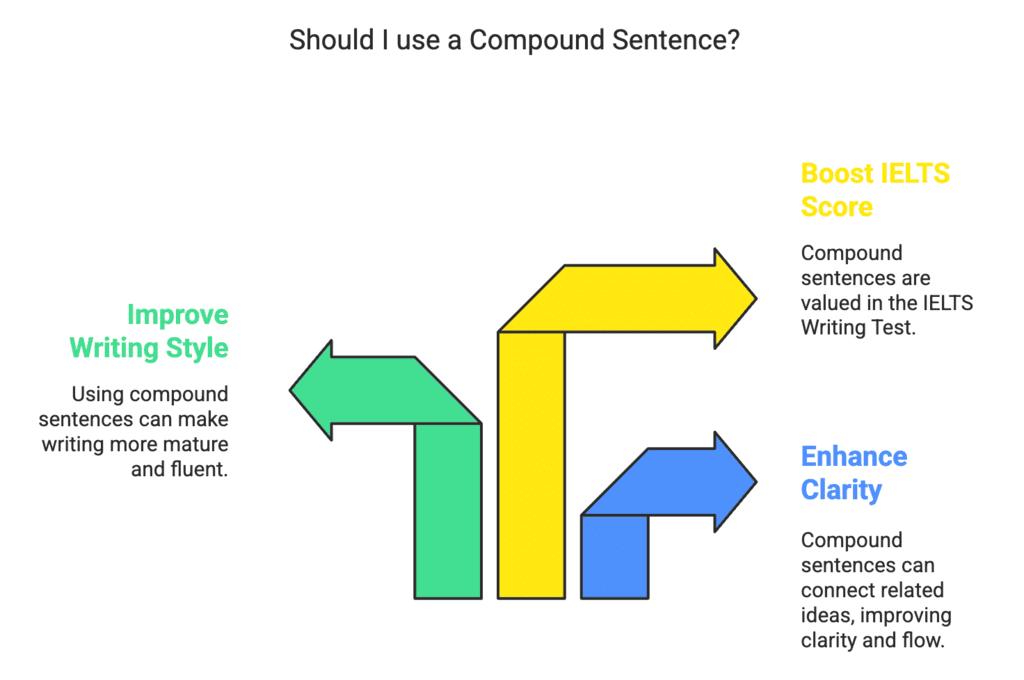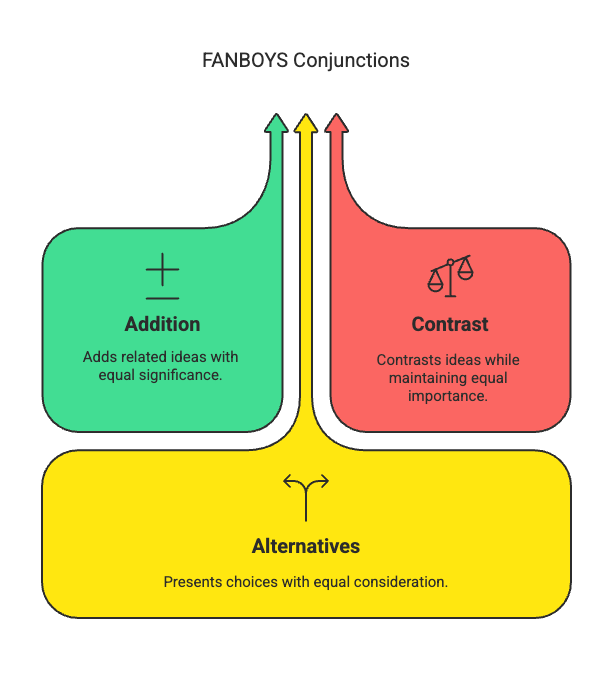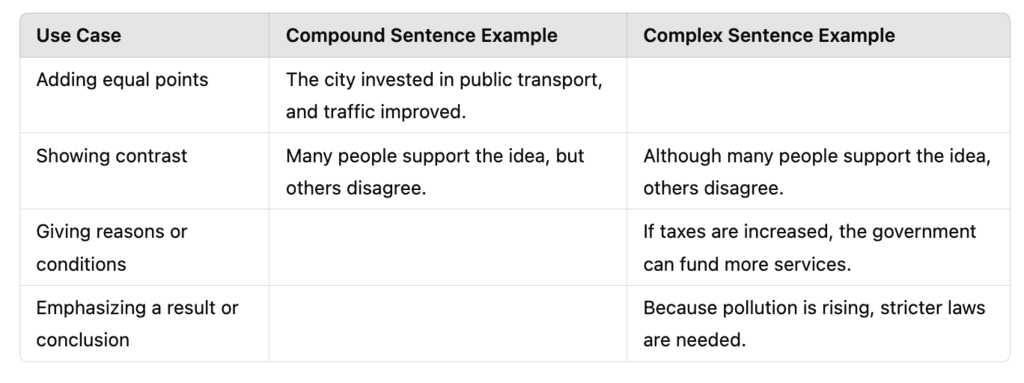Notes: Compound Sentences | Writing for Academic IELTS PDF Download
| Table of contents |

|
| What is a Compound Sentence? |

|
| Why Use Compound Sentences in IELTS Writing? |

|
| How to Form Compound Sentences |

|
| When to Use Compound vs. Complex Sentences |

|
| Practice for IELTS Writing |

|
Writing effective sentences is essential for scoring well in the IELTS Writing Test. One important skill that examiners look for is your ability to write a variety of sentence structures, including compound sentences.
This guide will help you understand what compound sentences are, how to form them, and why they’re important for IELTS.
What is a Compound Sentence?
A compound sentence is a sentence that consists of two or more independent clauses joined together to form a single sentence. An independent clause is a group of words that contains a subject and a verb and expresses a complete thought. In other words, each part of a compound sentence could stand alone as a complete sentence, but when combined, they create a more cohesive, fluent, and mature writing style.
Using compound sentences allows you to connect related ideas, compare or contrast facts, and present your points with greater clarity and flow. This is especially helpful in the IELTS Writing Test, where your ability to use a variety of sentence structures is an important part of your overall band score.

Example:
The graph shows a sharp increase in sales, and this trend continues into the following year.
Let’s break this sentence down:
"The graph shows a sharp increase in sales" is one independent clause. It makes sense on its own and has a subject ("the graph") and a verb ("shows").
"This trend continues into the following year" is another independent clause. It also forms a complete sentence on its own.
These two clauses are joined by the coordinating conjunction "and", forming a compound sentence.
The use of a compound sentence here links two related observations in a single sentence, making the writing smoother and more connected than if the ideas were presented separately.
Why Use Compound Sentences in IELTS Writing?
In the IELTS Writing test, especially in Task 2 (Essay), demonstrating your ability to write with grammatical variety is a key part of the Band Descriptors for Grammatical Range and Accuracy. One of the most effective ways to show this variety is by using compound sentences.
Compound sentences allow you to:
Demonstrate sentence variety: A mix of simple, compound, and complex sentences is essential for scoring Band 7 or higher.
Connect related ideas clearly: Compound sentences show how two thoughts are linked logically, whether through contrast, addition, or cause-effect.
Improve flow and coherence: Rather than writing short, choppy sentences, compound sentences help your ideas flow naturally from one to the next.
Create a more academic tone: Well-constructed compound sentences enhance the formal quality of your writing, which is expected in academic-style responses.
Using compound sentences appropriately shows that you can express ideas with clarity and control, and that you have mastered one of the core elements of advanced English writing.
How to Form Compound Sentences
There are three main methods for forming compound sentences. Each method joins two independent clauses—that is, two complete sentences that can stand alone.
1. Using Coordinating Conjunctions (FANBOYS)
FANBOYS stands for:
For, And, Nor, But, Or, Yet, So
These conjunctions join two independent clauses that are equal in importance.
Examples:
The economy improved, but unemployment remained high.
The number of students rose, so the university built more classrooms.
Rule: Place a comma before the coordinating conjunction when joining two independent clauses.
Use When:
You want to add, contrast, or present alternatives.
The two ideas are closely related and carry equal weight.

2. Using a Semicolon ( ; )
A semicolon can join two independent clauses without using a conjunction, provided the two ideas are closely related.
Example: The line chart shows steady growth; the bar chart presents a comparison.
Rule: Use a semicolon only between two complete thoughts that could stand as sentences on their own.
Use When:
You want to avoid overusing conjunctions.
The connection between the two ideas is clear and direct.
Tip: Don’t use a semicolon if the second clause starts with a subordinating conjunction (like "because", "although", or "while").
3. Using a Conjunctive Adverb or Linking Word
Conjunctive adverbs are transitional words or phrases that express relationships such as contrast, consequence, or addition.
Common examples:
however, therefore, moreover, consequently, nevertheless, furthermore
Examples:
The population declined; however, the birth rate remained steady.
Demand has increased; therefore, prices have risen.
Rule: Use a semicolon before and a comma after the linking word.
Use When:
You need to show a logical relationship between two ideas.
You want your writing to sound more formal and academic.
When to Use Compound vs. Complex Sentences
In the IELTS Writing Task 2 (the essay), using a variety of sentence structures is essential for achieving a Band 7 or higher in the Grammatical Range and Accuracy criterion. Two of the most useful types of sentence structures are compound and complex sentences. Although they may seem similar, they serve different purposes in writing.

Common Mistakes to Avoid
Writing compound sentences correctly requires not only joining two independent clauses but doing so with accuracy and clarity. Below are some common mistakes to watch out for:
1. Comma Splice
Mistake: Joining two independent clauses with only a comma.
Incorrect: The test was difficult, I managed to finish it.
Correct:
The test was difficult, but I managed to finish it.
or
The test was difficult; I managed to finish it.
or
The test was difficult. I managed to finish it.
Tip: Always use a conjunction, semicolon, or a period to join or separate independent clauses.
2. Missing Comma Before a Coordinating Conjunction
Mistake: Omitting the comma before for, and, nor, but, or, yet, so when joining two complete sentences.
Incorrect: Many people support the proposal but others are against it.
Correct: Many people support the proposal, but others are against it.
Tip: When both clauses are complete sentences, place a comma before the coordinating conjunction.
3. Using a Conjunction Without a Complete Second Clause
Mistake: Adding a coordinating conjunction, but not completing the second idea.
Incorrect: She prepared well for the test, and got a high score because.
Correct: She prepared well for the test, and she got a high score.
Tip: Each side of the sentence must be an independent clause—that is, it should make sense on its own.
4. Overusing Simple Conjunctions Like "and"
Mistake: Relying only on "and" to connect ideas, which can make your writing repetitive or unclear.
Poor Style: The government built new roads, and it opened new hospitals, and it invested in education.
Improved Version:
The government built new roads, opened new hospitals, and invested in education.
or
The government invested heavily in infrastructure; moreover, it focused on public health and education.
Tip: Use a range of conjunctions and linking devices (such as but, so, however, therefore) to show different relationships between ideas.
5. Confusing Compound with Complex Sentences
Mistake: Treating a dependent clause as an independent one in a compound structure.
Incorrect: Although it was raining, but we went out for a walk.
Correct (choose one structure):
Although it was raining, we went out for a walk. (complex sentence)
It was raining, but we went out for a walk. (compound sentence)
Tip: Don’t mix coordinating and subordinating conjunctions in one sentence.
6. Repetitive Sentence Patterns
Mistake: Using only one structure throughout your writing.
Example: The economy is growing, and jobs are increasing. Prices are rising, and inflation is a concern. The government is responding, and policies are changing.
Tip: While all of these are technically compound sentences, the repetition of structure lowers the overall quality. Mix complex and simple sentences to improve variety and flow.
Practice for IELTS Writing
Try combining the following sentences into compound sentences:
The data was surprising. It contradicted earlier predictions.
The student studied hard. She achieved a high band score.
There were delays in construction. The project was not completed on time.
Challenge: Use different joining methods (FANBOYS, semicolons, linking words).
Final Tips
Use compound sentences alongside simple and complex sentences for variety.
Don’t overuse them—clarity and accuracy matter most.
Practice combining your ideas smoothly to create a logical flow in essays and reports.
|
30 videos|206 docs|17 tests
|
FAQs on Notes: Compound Sentences - Writing for Academic IELTS
| 1. What is a compound sentence? |  |
| 2. Why should I use compound sentences in IELTS writing? |  |
| 3. How can I form compound sentences? |  |
| 4. When should I use compound sentences instead of complex sentences? |  |
| 5. What practice can I do to improve my use of compound sentences for IELTS writing? |  |




















